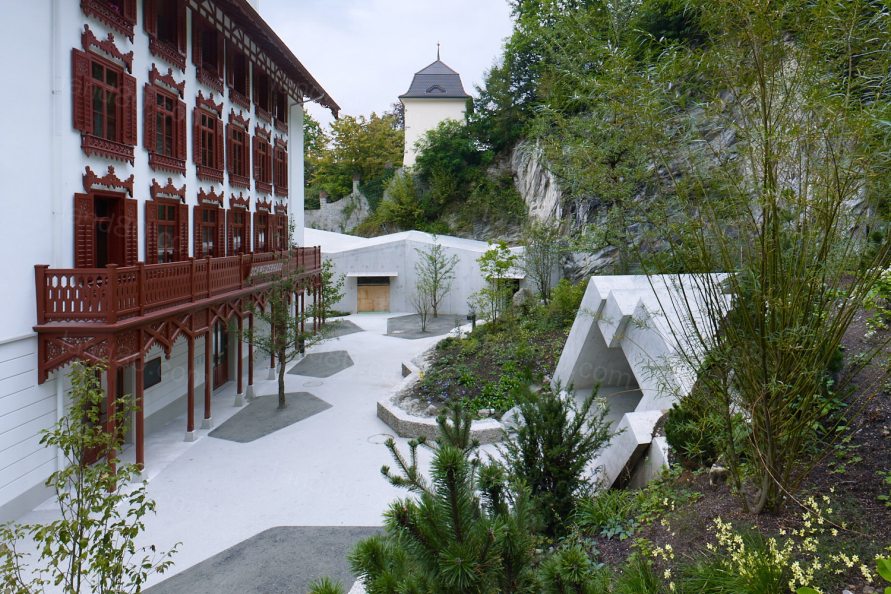冰川花园位于卢塞恩(Lucerne)市的一块大砂岩脚下。砂岩的起源可以追溯到2000万年前形成卢塞恩热带地区的海滩。
The Gletschergarten is located at the foot
of a large sandstone rock in Lucerne. The origin of the sandstone goes back to
a marine beach that formed the then tropical area of Lucerne 20 million years
ago.

冰川花园的扩建受到19世纪科学热情的启发。当时人们广泛拥有探索自然的幻想和好奇心,甚至想要洞察那些神秘现象,这会引导游客穿过冰川花园。与儒勒-凡尔纳(JulesVerne)的冒险小说中的主人公相似,游客们独自或以小组形式前往一个异世界。随着故事发展的旅程就是目的地。在卢塞恩之旅中,游客们获得了充满想象力的体验,并可以对各种科学现象进行探索和研究。这是一个自然科学、冒险小说和乌托邦元素的多样化结合的项目。
The interventions in the Glacier Garden are
inspired by the scientific zeal of the 19th century. The romantic curiosity
with which people explored nature at that time and wanted to penetrate even
uncanny phenomena should also guide visitors through the Glacier Garden.
Similar to the protagonists in an adventure novel by Jules Verne, visitors
travel alone or in small groups to an alien world. The story virtually develops
on its own - the journey is the destination. During the Lucerne Journey to the
Center of Time, visitors are imaginatively entertained and various scientific
phenomena can be explored and investigated. It is a diverse juxtaposition of
natural science, adventure novel and utopian elements.


穿过入口,就能进入岩石世界。 渐渐地,人们会被岩石带来的气候所环绕:岩石内部会形成潮湿的空间环境,并且基本不受季节影响。沿着这条路径,可以发现和体验到地球历史上的不同自然现象。
Through the access portal, one reaches the
very own world lying in the rock. Gradually, one is embraced by the climate of
the rock: a humid environment of spaces driven into the rock, largely
independent of the seasons. Along the path, different phenomena of the earth's
history can be discovered and experienced.



强烈的空间氛围是由主要材料石头,以及光与暗、封闭与开阔、声音与沉默的元素体验形成的。空间的几何形状和位置以砂岩的普遍分层为导向,由于山体的褶皱和现有的裂缝,砂岩并不平坦。这使得廊道和洞穴出现斜切面,增强了空间的独特氛围。岩石在许多地方都是可⻅的,只是出于安全考虑才对游客进行隐蔽性保护,并在关键部分进行加固。游客通过楼梯到达萨默罗,爬上花园庭院一侧的岩壁。
The strong spatial mood is shaped by the
predominant material, stone, and the elemental experiences of light and dark,
confinement and expanse, sound and silence. The geometry and location of the
rooms are oriented to the prevailing stratification of the sandstone, which is
out of plumb due to Alpine folding, and the existing fissures. This leads to
oblique cross-sections of passages and caverns, which reinforces the specific
perception of the rooms. The rock is left visible in many places and only
secured invisibly to visitors where necessary for safety reasons.

参观者从大约三十米的深度,一步步爬上光线触及的地方,体验并感知这种基础的自然现象。
Visitors reach the Sommerau via a staircase
that climbs up the rock face on one side of the garden courtyard. From a depth
of about thirty meters, visitors climb step by step towards the light and
experience elementary natural phenomena and perceptions.


新的博物馆空间将建在场地的北部,作为山的延伸,设计师使用挖掘出来的材料作为混凝土结构。Schweizerhaus本身的特性得到了加强。这是一座典型的历史建筑,具有独特的室内设计。带有博物馆商店的小酒馆被建在建筑的第一层,面向南方,从这里也可以通往露台空间。
The new museum rooms will be built in the
northern part of the site as an artificial extension of the mountain, using the
excavated material as a concrete structure. The qualities of the Schweizerhaus
itself have been strengthened. It is a typical historical residential building
with remarkable interior. A small bistro with a museum store was built into the
first floor of the building facing south, from which the terrace areas are also
used.
▽场地平面

▽平面图

▽剖面图
Project name: Museum extension
Gletschergarten Lucerne
Company name: Miller & Maranta dipl.
Architekten ETH BSA SIA Schützenmattstrasse 31, 4051 Basel
Website: www.millermaranta.ch Contact
e-mail: info@millermaranta.ch Project location: Lucerne, Denkmalstrasse 4
Completion Year: 2022 Building area (.0m²): approx. 500 Other participants: -
Photo credits: Ruedi Walti, Kannenfeldstrasse 22, 4056 Basel
|